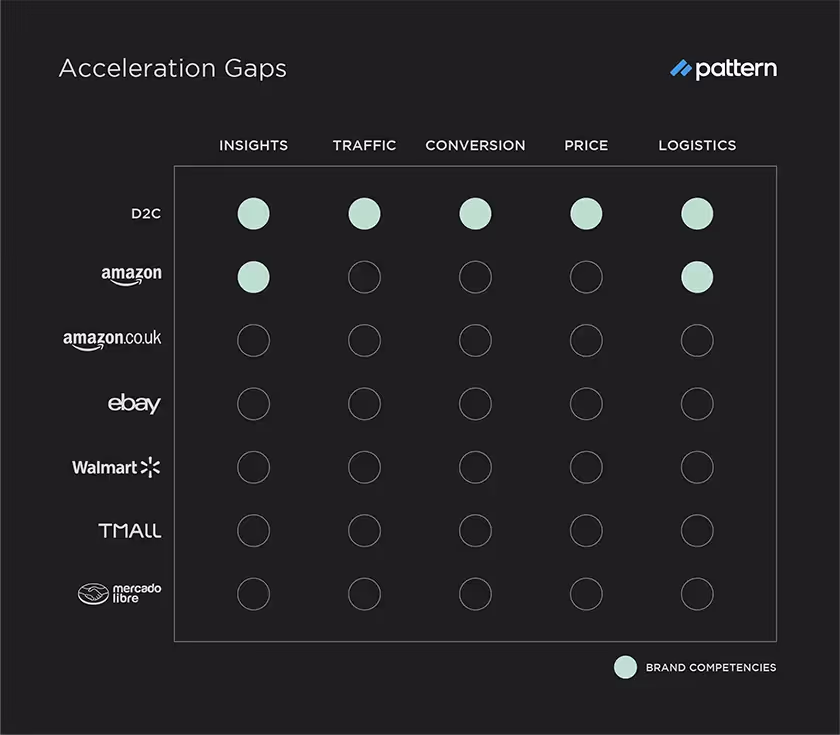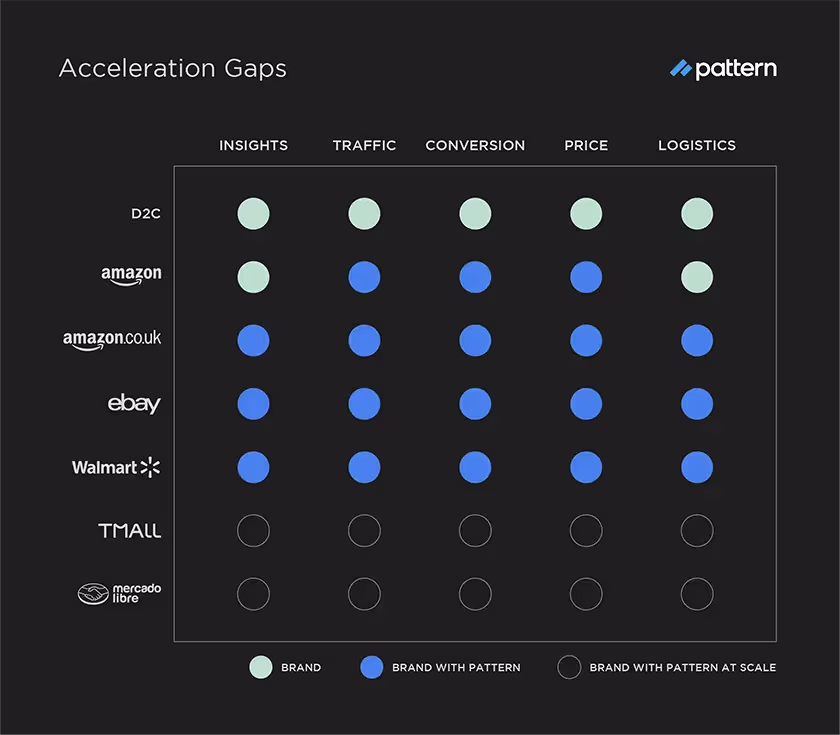What Are Acceleration Gaps? How Pattern Helps CEOs Fill in the Gaps For Rapid Growth
Ecommerce growth isn’t as simple as developing and listing a great product. All brands run into challenges as they expand their D2C sites and onto marketplaces and run their resources a little too thin for optimal growth.
Despite having countless different approaches and priorities, most CEOs share at least one goal—growing their brands faster and with more profit across all ecommerce channels and marketplaces. But ecommerce growth isn’t as simple as developing and listing a great product.
All brands run into challenges as they expand their D2C sites and onto marketplaces like Amazon, Walmart, eBay, Tmall, and Mercado Libre. The common thread of these challenges? Brands lack the resources and skills to successfully expand and thrive on ecommerce. What does this look like?
It may mean that your brand wants to expand to international Amazon marketplaces, but you don’t have anyone on your ecommerce team who knows how to do that effectively. Maybe you want to make data-backed decisions, but your insights are so scattered between marketplaces that it’s difficult to form a clear picture of how your products are performing compared to competitors.
You may have an amazing product, but you’re lacking a top-notch creative team to help you powerfully convey your product’s key features. While these challenges may look slightly different for every brand, in all cases, they cause what we call “acceleration gaps.” Acceleration gaps are just that—deficiencies in a brand’s ecommerce strategy that keep them from accelerating their ecommerce growth and reaching their full ecommerce potential.
What exactly are acceleration gaps? How can your brand identify them? And, most importantly, what can you do to fill these gaps and maximize profit? Below, we’ll answer each of those questions and more.
What are acceleration gaps?
At Pattern, we’ve found that brands succeed on ecommerce marketplaces when they master five core competencies—insights, traffic, content, price, and logistics. We use this framework to grow our brand partners and achieve global success. To master insights, brands need to consolidate data to make data-backed decisions. To master traffic, brands need to increase traffic across marketplaces through SEO and advertising.
To master content, brands need to optimize content to boost conversion. To master price, brands need to monitor price and sellers to maintain control and uniformity. Finally, to master logistics, brands need to sell everywhere, remain in stock, and reduce shipping costs. Brands see acceleration gaps when they do not master any of these core competencies on any ecommerce channels. It may look something like this:

The example brand in the graphic above has mastered the 5 core competencies on its D2C site. But on Amazon, although the brand has a solid handle on insights and logistics, it struggles to drive traffic to its listings, convert that traffic to purchases, and maintain price parity. Although there may be significant demand for the product on other marketplaces, the brand hasn’t expanded to them yet.
These acceleration gaps—which are likely due to a lack of resources, knowledge, skills, or any combination of the three—aren’t uncommon. Small teams are often expected to run ecommerce for even massive brands, and it’s unrealistic to expect 2 or 3 people to have both the time and expertise to master every core competency on every ecommerce channel in every market. Even if your ecommerce team is highly trained and qualified, there may just not be enough hours in the day to fill these gaps. Despite acceleration gaps being common and even understandable, they still keep brands from growing their presence and profit on ecommerce.
How can I identify my brand’s acceleration gaps?
Unfortunately, acceleration gaps aren’t typically as obvious as they seem in the graphic above. However, there are a few questions you can ask yourself to help you identify where your brand falls short on ecommerce.
First, you can ask yourself this: “Am I currently on any marketplaces other than Amazon?” If the answer is no, your first acceleration gap is evident. Your brand needs to focus on expanding its reach across marketplaces to new audiences and greater visibility. If the answer is yes, you can then ask yourself, “Am I on all Amazon marketplaces across the world where there’s demand for my product? Besides Amazon, are there other marketplaces I should be on that I’m not?”
If you’re on all marketplaces that could increase your profit, you can begin looking at where you fall short in specific core competencies on each channel. The graphic below may be a helpful tool in forming these questions. Do you know where you stand compared to competitors? Is your advertising strategy building your organic reach? Is your creative content consistent across channels? Are you consistently winning the Buy Box and maintaining MAP? Do you struggle to keep your product in stock? It can be overwhelming to handle all of these things at once, so focus on each competency, one at a time, to really understand how your brand performs.

As you evaluate your brand’s performance in each of the core competencies, your acceleration gaps will soon become evident. In general, you can find acceleration gaps in any area of your ecommerce strategy that could be improved with more time, resources, or expertise. Thoughts like, “If we just had the time, we could really thrive on that marketplace,” or “If I had more people with the right skills, we could do better in this area,” or “I wish we could expand to that part of the world, but it’s just not feasible” can all point to potential acceleration gaps.
While every brand will struggle with different acceleration gaps, there are a few common gaps to watch for. The first is a lack of clear data and coherent insights. Ecommerce data is often compartmentalized and difficult to analyze quickly. Brands also commonly see gaps in their content, especially when they expand to international marketplaces but don’t create customized content in the target language. Price becomes an acceleration gap when brands have unauthorized sellers, multiple ecommerce partners, and inconsistent pricing.
How can I fill my brand’s acceleration gaps?
There are two ways that brands can fill their acceleration gaps. The first is to hire more people that have experience in the areas you’d like to improve in. While potentially effective, this method gets very expensive very quickly. (And it’s also a never-ending game.)
The second option is to partner with an ecommerce accelerator like Pattern, which has the resources to help brands master all the competencies on every ecommerce marketplace. When you partner with us, you enlist the help of our state-of-the-art software and highly qualified ecommerce teams who specialize in each competency. Let’s return to our example brand above. After becoming aware of its acceleration gaps, the brand partnered with Pattern. Where the brand fell short on its own, Pattern stepped in and filled the gaps:

Our proprietary software provided easy-to-read data and actionable insights for every marketplace and helped easily enforce MAP policy. In fact, after working with Pattern this brand saw 98.9% MAP compliance. Our advertising and SEO teams optimized strategies to make the most of advertising money, driving increased traffic to product listing pages. Our first-class creative teams crafted powerful content to convert traffic at a much higher rate.
Our global distribution network made shipping internationally easy and attainable. Additionally, we helped the brand expand to every marketplace that saw a demand for the product. Overall, this brand saw a 1250% increase in sales rank and a 73% average monthly revenue increase during the 1st year working with Pattern. Not too shabby for simply filling a few acceleration gaps. Ready to see these results for yourself? We can help your brand where you need it most. Learn how we can identify and fill your acceleration gaps at no cost to you: Get in touch today.


.jpg)





.jpg)

